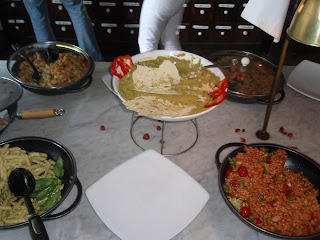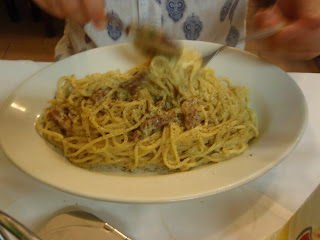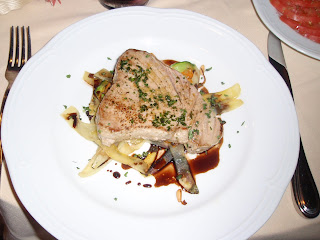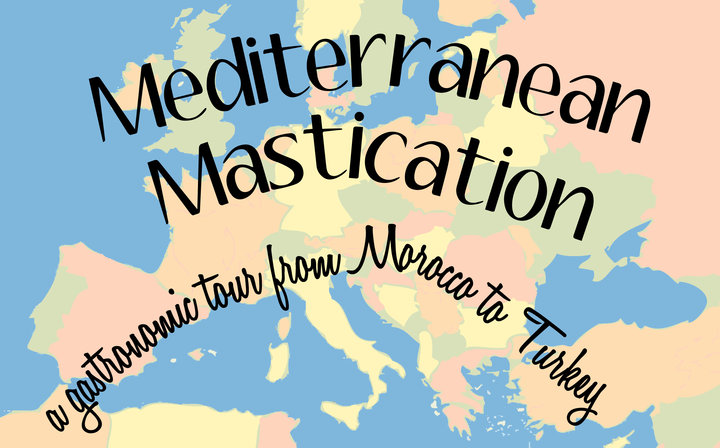Apologies for the lack of postings lately, but after a few computer hiccups I am finally back online and ready to go.
Italian cuisine (which I'm sure needs no introduction) is noted for its regional diversity, abundance of difference in taste, and is known to be one of the most popular in the world, with influences spreading to all corners of the globe.
Ingredients and dishes vary by region. Many dishes that were once regional, however, have proliferated with variations throughout the country. Cheese and wine are a major part of the cuisine, with many variations and Denominazione di origine controllata (DOC) (regulated appellation) laws. Coffee, specifically espresso, has become important in Italian cuisine.
After my Sicilian chow-down, I spent 2 weeks wandering around Naples, the Sorrentine peninsula, the Amalfi Coast and finishing up in Roma for 4 days.
Here is the fruits of my labour after trawling through the many trattorias, ristorantes, pizzerias, pasticcerias & enotecas (wine bars).
Colazione - (Breakfast)
Italians don't tend to eat a sit-down breakfast, perferring instead a cappacino and cornetto (croissant) at a bar.

Pranzo - (Lunch) & Cena - (Dinner)
Lunch is regarded as being the most important and is the heaviest Italian meal. Most shops close down in the pausa di pranzo (lunch break) between 13.00 and 16.00, and most people, even workers, come home to have a meal with their family, often inviting friends and relatives to come along. Dinner is usually a lighter meal (traditionally) in Italy, and locals usually dine out at dinner in Italy rather than at lunch time.
Traditional structure of Italian meals
Apertivio
The aperitivo opens a meal, and it is virtually the same to an appetiser or drinks given at the beginning of a meal. Many bars in Rome provide spreads of apertivio with the purchase of a beverage.


 Antipasto
AntipastoThe antipasto is the slightly heavier starter course. It is usually cold (not in all cases) and lighter than the first course, but heavier then the apertivio. Cold meats and hams (salami, mortadella, Parma ham etc.), cheeses (mozzarella, scamorza), sandwich-like foods (panini, bruschette) are usually eaten.
 Procuitto & mozzarella
Procuitto & mozzarella Bruschetta pomodoro
Bruschetta pomodoro Toast with mozzarella, anchovies & cherry tomatoes
Toast with mozzarella, anchovies & cherry tomatoes
 Seafood Antipasti platters
Seafood Antipasti plattersPrimo
The primo is the first course. It is hot food and heavier than the antipasto, but lighter than the second course. It usually consists of non-meat or fish like foods. Examples of things which would be eaten at a primo could be risotto, pasta and spaghetti, soup and broth, gnocchi, polenta, crepes, casseroles, vegetables, vegetarian-like lasagnas, pizza, or grilled/fried courgettes/aubergines/artichokes.
Pasta
 Spaghetti alla Carbonara
Spaghetti alla Carbonara Orichette with spinach
Orichette with spinach Penne with tomato & aubergine
Penne with tomato & aubergine Spaghetti vongole (with clams)
Spaghetti vongole (with clams)Pizza
Pizza is the most popular and best known creation of all Neapolitan cuisine.

Real Neapolitan pizza must be cooked in a wood-fired oven, hand-made by an able pizziaiolo who makes the dough disk thinner in the center and thicker in the outer part; the ingredients and olive oil are rapidly spread on the disk, and with a quick movement the pizza is put on the shovel and then slid in the oven where it is turned around a few times for uniform cooking.
 Woodfired pizza oven (forno a legna)
Woodfired pizza oven (forno a legna) Proscuitto & funghi pizza
Proscuitto & funghi pizza D.O.C. pizza - essentially Margherita pizza (Mozzarella di Bufala , basil & tomato base)
D.O.C. pizza - essentially Margherita pizza (Mozzarella di Bufala , basil & tomato base) Authentic Neapolitan pizzas are typically made with tomatoes and Mozzarella cheese. They can be made with fine ingredients like San Marzano tomatoes, which grow on the volcanic plains to the south of Mount Vesuvius, and Mozzarella di Bufala Campana, made with the milk from water buffalo raised in the marshlands of Campania and Lazio in a semi-wild state (this mozzarella is protected with its own European protected designation of origin - D.O.C).
In 1889, during a visit in Naples, Queen Margherita of Savoy was served a pizza resembling the colurs of the Italian flag, red (tomato), white (Mozzarella) and green (basil). This kind of pizza has been named after the Queen as Pizza Margherita.
 Primavera pizza
Primavera pizza Neapolitan tuna & olive pizza
Neapolitan tuna & olive pizzaSecondi
The secondo is the heartiest and main course of an Italian meal, sometimes called the piatto principale or the main course/meal. It is made up usually of meats and fishes, including turkey, sausage, pork, steak, stew, beef, zampone, cod (baccala), salmon, lobster, lamb, chicken, meat lasagna or a roast.
 Tuna steak
Tuna steak Rack of lamb
Rack of lambInsalata
 Tomato & rocket salad
Tomato & rocket saladDolce
After the secondo there is the dolce, or dessert. It is popular, and meals eaten here depend by region and occasion. Common ones include tiramisu, panettone, pandoro, zuppa inglese or panna cotta. Gelati or granita can be eaten too.

Tiramisu - one of the most popular Italian desserts, made of cake dipped in coffee, layered with a whipped mixture of egg yolks and mascarpone, and flavored with liquor and cocoa.

Sfogliatelle - a flaky pastry filled with sweet cinnamon ricotta native to Naples.

Panna Cotta - an Italian dessert made by simmering together cream, milk and sugar, mixing this with gelatin, and letting it cool until set. It is generally from the Northern Italian region of Piemonte, although it is eaten all over Italy, where it is served with wild berries, caramel, chocolate sauce or fruit coulis.

 And guess what... MORE gelati!
And guess what... MORE gelati!Vino
Red wine served chilled in carafes... who can say no?!

Phew! I guess there's a reason I'm feeling a little bit chunkier after all that! Croatian post coming in the next day or so.
Until then, CW xo

No comments:
Post a Comment